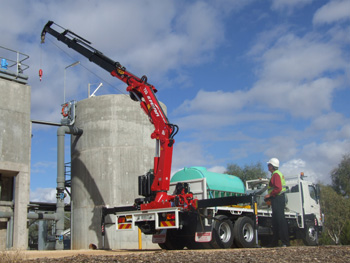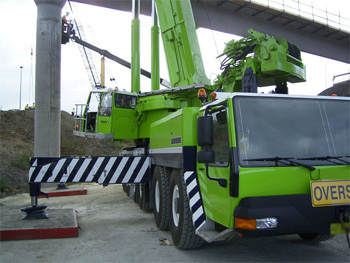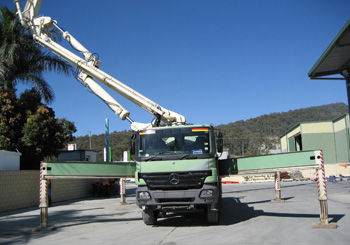Vehicle stabilisers and outriggers
Published: 10 February 2014
Last updated: 2 August 2018
Purpose
The purpose of this safety alert is to highlight the risks associated with stabilisers and outriggers on trucks and trailers when travelling on public roads.
Background
In February 2018 a truck, fitted with a vehicle loading crane (VLC), was driven along a road with its stabiliser extended. The stabiliser struck a parked vehicle, and a worker standing behind this vehicle was crushed and killed.
A similar incident occurred in 2013, when a manually-operated stabiliser on a truck, fitted with a vehicle load crane, unintentionally extended while travelling on a public road and killed a cyclist.
In 2016, an outrigger on an amusement ride trailer swung out while being driven on a public road and hit a vehicle heading in the opposite direction, killing the driver. Similar incidents have occurred elsewhere in Australia and internationally.
Stabilisers and outriggers have many configurations depending on the application and are used to minimise the risk of toppling when the centre of gravity of the combined load and vehicle is outside the support base of the vehicle. Outriggers lift the vehicle's wheels off the ground while stabilisers do not.
Examples of mobile plant using stabilisers or outriggers include:
- mobile cranes
- truck mounted elevating work platforms
- vehicle loading cranes
- mobile concrete placement booms
- mobile amusement rides.

Photograph 1: Vehicle loading crane with stabilisers on truck

Photograph 2: Mobile crane with outriggers

Photograph 3: Mobile concrete placement boom with outriggers
Contributing factors
Manually operated stabilisers rely solely on the locking mechanism to ensure the stabiliser remains in the travel position.
The stabiliser can extend due to:
- the stabiliser not being returned to and effectively locked into the travel position
- the stabiliser restraining mechanism failing
- incidental forces, such as, when the truck goes over a bump or around a corner.
Hydraulically operated stabilisers still require effective restraint during road travel, but they are less likely to extend due to the resistance afforded by the hydraulic system.
Action required
For safety, make sure:
- components of the stabiliser or outrigger travel restraint locking mechanism are:
- in good condition
- operating correctly
- free of defects
- inspected and maintained in accordance with the manufacturer's recommendations and/or guidance provided in relevant technical codes and standards.
- the locking mechanism for manually extended VLC stabilisers should include two separate latching devices for each stabiliser and at least one of these should be automatically operated (e.g. a manually operated securing pin and an automatic spring latch)
- workers who drive the vehicles are provided with appropriate instruction, training and supervision regarding the proper use of the stabiliser or outrigger and the associated locking mechanism. The training should relate to the specific make and model of plant and be documented.
Owners of vehicle loading cranes without secondary locking mechanisms on the stabilisers should consider engaging an engineer or the manufacturer to redesign and modify the locking mechanism to eliminate or minimise the risk of a stabiliser inadvertently extending while travelling on public roads.
Vehicle loading cranes manufactured prior to 2004 may only have a single locking device for each stabiliser. Cranes more than 10 years old should have the safety features, including secondary locking devices on stabilisers, updated as part of the major inspection in accordance to AS 2550.11 Cranes, hoist and winches – Safe use Part 11 vehicle loading cranes. Any vehicle loading crane fitted with manually extending stabilisers should have both a primary and secondary locking system fitted to each stabiliser.
In view of the three fatal incidents, where a truck has been driven without the driver being aware of an extended stabiliser, it is considered reasonably practicable to retrofit cranes with a stabiliser warning system in accordance to the applicable Australian Standard. The feasibility of fitting an upgraded warning and indicating system to older vehicle loading cranes should be assessed during the annual inspection and maintenance program for the crane.
The current Australian Standard (AS 1418.11-2014 Cranes, hoist and winches Part 11: Vehicle-loading cranes) specifies the provision of an indicator to warn that the stabilisers are not locked in the transport position. Cranes manufactured to comply with this standard should include a warning system that is both visible and audible to the driver (i.e. a warning light with a buzzer in the truck cabin).
Further information
- Mobile Crane Code of Practice 2006 (PDF, 1.34 MB)
- Vehicle loading cranes self-assessment tool (PDF, 0.25 MB)
- Managing the risks of plant in the workplace Code of Practice 2021 (PDF, 1.57 MB)
- How to manage work health and safety risks Code of Practice 2021 (PDF, 0.65 MB)
- Australian Standard AS 1418.11-2014 Cranes, hoists and winches Part 11: Vehicle-loading cranes
- Australian Standard AS 2550.11 Cranes, hoist and winches – Safe use Part 11 vehicle loading cranes